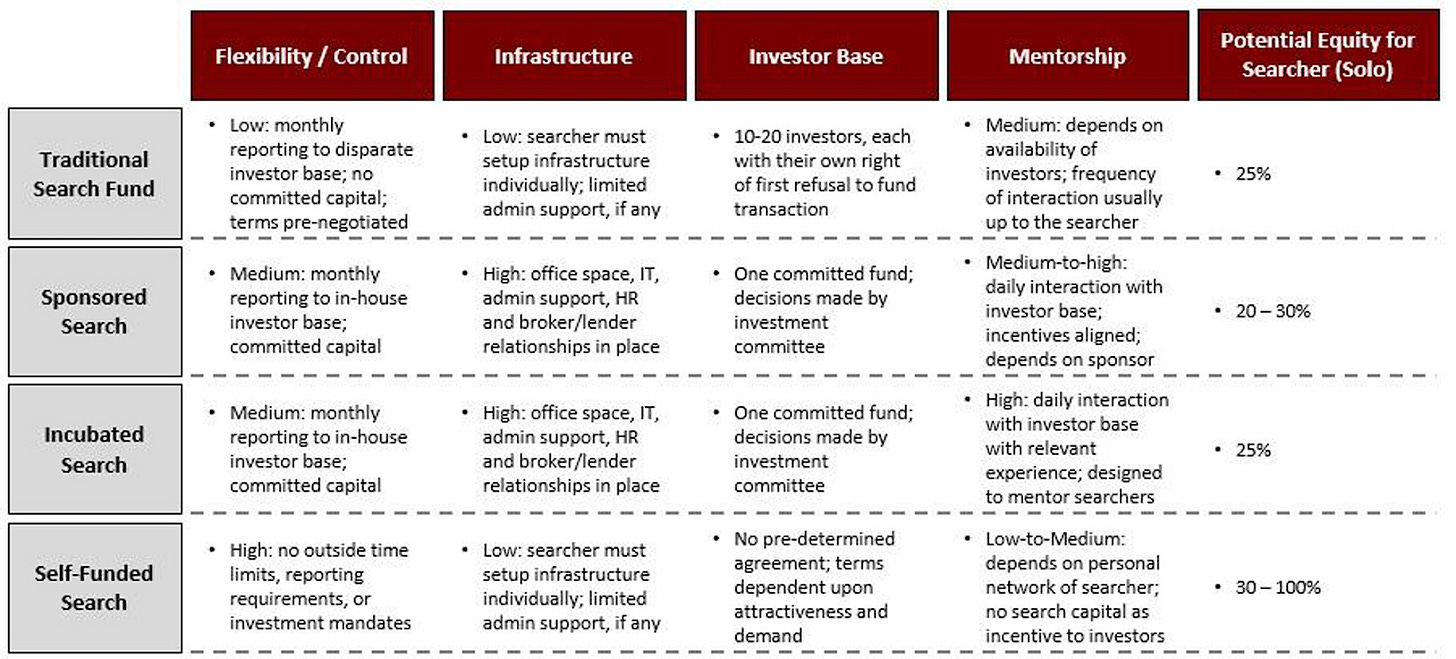ETA: A Practical Approach to Business Ownership
How Acquiring an Existing Business Offers a Smart Alternative to Startups In a 3-Minute Read
Learn with AI:
The Gist
With an estimated $72 trillion in business ownership transitioning in the coming years, Entrepreneurship Through Acquisition (ETA) presents a compelling path for aspiring entrepreneurs.
What Needs to be Understood:
Defining ETA: ETA is when you focus on acquiring and operating an existing, cash flowing business rather than launching a new venture from 0 to 1.
Historical Context: The concept of the "search fund" formalized in 1984 by Harvard Business School's Irv Grousbeck, offering a structured pathway for MBA graduates to identify, acquire, manage, and grow a privately held company.
There Are Many Models
Traditional Search Fund: This model involves raising capital from investors across two phases: initial funding for the search process and subsequent capital for the acquisition itself.
Self-Funded Search: You’ll utilize your personal capital to finance the search for an acquisition target. This approach gives you control, freedom, and equity ownership but requires a higher degree of personal financial risk tolerance. Acquisition financing may still involve external debt or seller financing.
Sponsored Search: You’ll partner with a single investment firm, typically a family office, which provides all necessary capital for both the search and the acquisition.
Incubated Search: A relatively newer model where you’ll join an established incubator platform specializing in search fund investments.
The ETA Process
Phase 1: Search Fund Formation (2-4 months)
For traditional models, this involves investor outreach, developing a compelling investment thesis, and securing initial capital commitments.
Key Activities and Deliverables:
Create Private Placement Memorandum (PPM) and investment thesis
Network and pitch to potential investors
Secure investor commitments
Complete legal fund formation
Phase 2: Opportunity Sourcing and Evaluation (1-24 months)
A systematic process of identifying potential acquisition targets, conducting due diligence, and assessing their financial and operational viability.
Key Activities and Deliverables:
Build and execute systematic outreach strategy
Screen opportunities against investment criteria
Conduct preliminary due diligence
Build relationships with business owners
Phase 3: Transaction Financing and Closing (2-6 months)
Securing the necessary financing for the acquisition, negotiating final terms, and completing the legal and administrative processes to finalize the deal.
Key Activities and Deliverables:
Negotiate and execute Letter of Intent (LOI)
Complete comprehensive due diligence
Secure transaction financing
Execute purchase agreement and closing
Phase 4: Business Operations (4-8 years)
Assuming leadership and operational control of the acquired business, focusing on growth, efficiency improvements, and value creation.
Key Activities and Deliverables:
Execute owner transition and 100-day plan
Build/strengthen management team
Implement key strategic initiatives
Establish effective board governance
Phase 5: Exit Strategy (4-6 months)
Executing a sale of the business to realize a return on investment for both the entrepreneur and investors (if applicable).
Determine optimal exit timing and strategy
Prepare business for sale
Engage with potential buyers
Execute final transaction
Observations:
Historically an MBA Has Been The Pathway: The search fund ecosystem has historically been heavily populated by graduates from top MBA programs.
Small Businesses Are Important: Accounting for 44% of all economic activity and employing 46% of private workforces.
The Returns Aren’t Bad: Search funds generate, on average, a 33% IRR and a 5.5x multiple on invested capital.
An Average Search Fund Takes: Approximately 19 months to find and acquire a company.
The Average Starting Capital of a Search Fund: Approximately $426,000
Ideal Target Business Profile:
Financial Characteristics
Valuation: $5-30 million
EBITDA: $1.5-5 million annually
Strong, stable cash flows
Healthy balance sheet with manageable debt
Business Attributes
Industries: Manufacturing, distribution, business services, healthcare, technology
Growth potential through operational improvements or market expansion
Strong market position within defined geography
Established business model with proven profitability
Opportunity for management transition (often retiring owner)
Strategic Considerations
Majority/full control acquisition preferred
Clear opportunities for value creation
Potential for operational improvements
Defined exit path within 5-10 years
Something to Think About:
How much risk are you comfortable with?
To what extent are you willing and able to deploy your own capital in pursuing an acquisition?
What level of ownership is your target?
How much day-to-day involvement do you want in the business you are seeking?
What level of external support, mentorship, and infrastructure do you perceive as necessary for your success in this endeavor?
Insights from Chicago Booth:
The Search Fund Basics From Stanford:
An MBA Favorite:
SBA 7(a) loans:
Seller’s Note:





